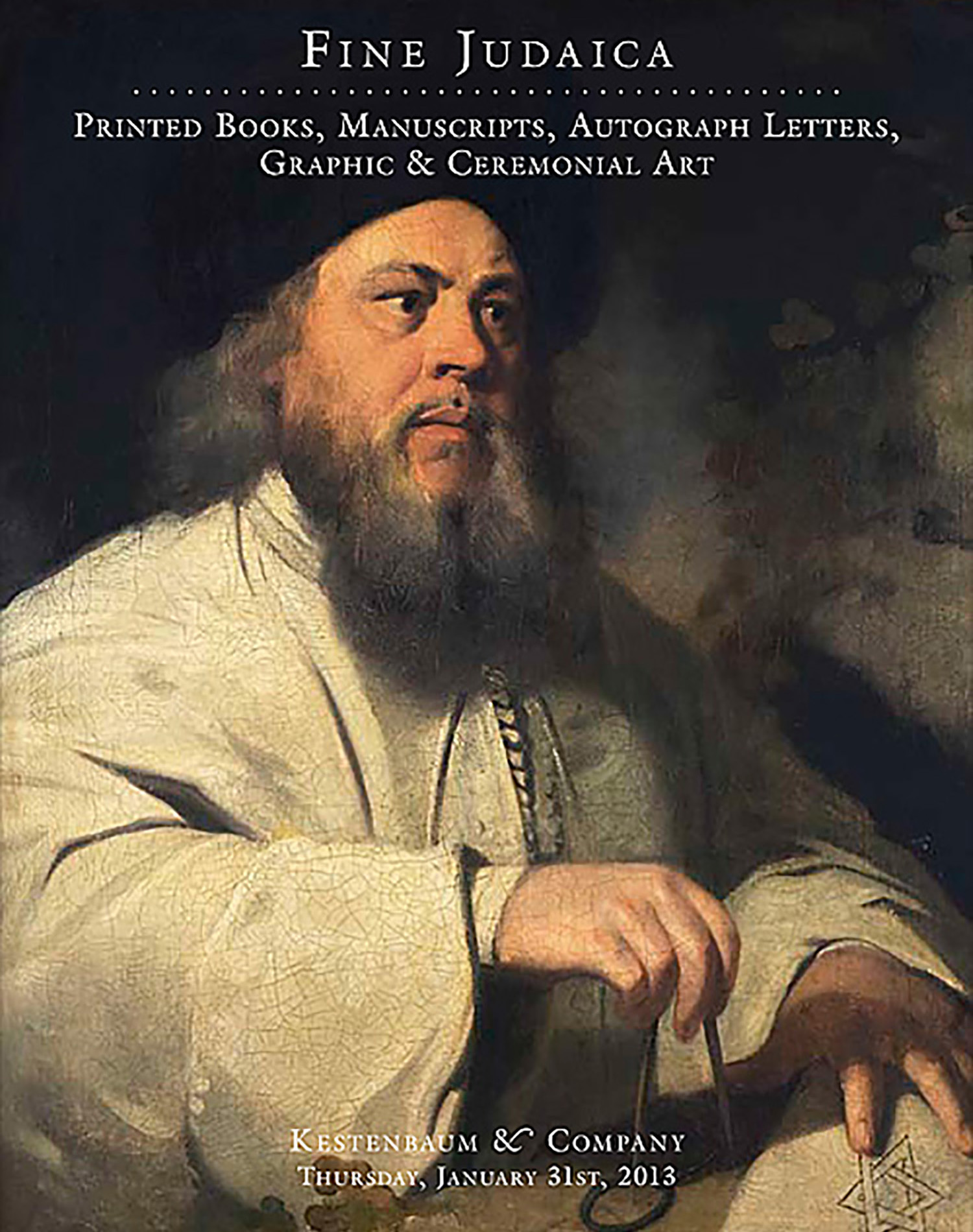EXCEPTIONALLY FINELY EMBROIDERED LINEN TORAH BINDER.

AUCTION 57 |
Thursday, January 31st,
2013 at 1:00
Fine Judaica: Printed Books, Manuscripts Autograph Letters, Graphic & Ceremonial Art
Lot 368
EXCEPTIONALLY FINELY EMBROIDERED LINEN TORAH BINDER.
1844
Est: $5,000 - $7,000
This colorfully embroidered Torah binder is written in the classic phrasing of a wimpel - the swaddle-cloth used at a baby’s brith-milah, and later, upon turning three years, is brought by the young boy to the synagogue for use as a Torah binder.
As per tradition, the life-cycle events alluded to in the text of the binder are each illustrated with fanciful motifs and symbols, playfully found above, below and within the respective words of the text.
The present example contains many unusual iconographic symbols, a selection of which are recorded below:
At the start of the wimpel’s narrative appears a delightful image of a gentleman watering his garden, perhaps alluding to God as the Source of all life, enabling man to grow from newborn to adult. * Beginning with the child’s name ‘Shimon’ and later the word ‘nolad’- (was born) we see the use of fish, a metaphor for fertility. * Within the letters of the honorific of the father (‘MHRR’) are a pomegranate, representing fruitfulness; a pair of candlesticks and challah symbolizing the Shabbos; a table with two chairs and lit candles, alluding to domestic harmony and the two sets of Tablets suggesting the Written and Oral Torah. * The zodiac sign for Cheshvan, the month of the child’s birth, is illustrated by a Scorpio, depicted below the month’s name. (Indeed zoological images appear throughout, including: Lion, mongoose, hummingbird, swan and others). * A winged figure with tambourine and trumpet - Angel Gabriel - embroidered entirely in white thread appears to float heavenward above the father’s name ‘Gavriel.’ Below the Hebrew, the father’s name used in secular circles: Hirsch Frierman. * Below the Hebrew year, is a charming depiction of a steam engine. Similarly, atop the end of the date, appears a man beside a box-camera, a newly introduced phenomenon at this time, 1844. Inclusion of these modern contraptions appears to be a sign of pride in the new innovations of the time. * Above the father’s second name, Naftoli, is a charming hatted figure (minstrel?) playing his flute while relaxing in the foliage that has grown from the Hebrew letter ‘lamed.’ * Other more curious images include a bird (vulture?) attacking an animal carcass - seen above the ‘kuf’ of ‘Shabbas Kodesh.’ Within the letter ‘lamed’ of ‘Mazel’ there appears a recumbent figure with an indistinguishable item beside him.
The final portion of the binder records the well-wishes to the child for his future: “L’Torah, L’Chupah, Ul’Ma’asim Tovim.” The word ‘Torah’ appears within an opened Torah Scroll with six words smaller below encompassing the various books and levels of Torah, Mishnaic, Talmudic and Midrashic learning. * Atop the word ‘chupah’ is a rabbi officiating at a Jewish wedding - with wine goblet in one hand and liturgical text in the other. He stands in front of a small house alluding to the blessing given to the newly married – to be worthy of building a home according to the Jewish traditional values. * The word ‘chupah’ is followed by a three-dimensional depiction of a wedding canopy housing two verses from Isaiah associated with the marriage rite: “Glory instead of ashes” (61:3) and “Like a bridegroom, who, priest-like, dons garments of glory, and like a bride, who adorns herself with her jewelry” (61:10).
<<Provenance:>> De-accessioned from the Collection of the Hechal Shlomo Museum, Jerusalem (with museum tag attached).
For similar, see Judah Magnes Museum, Torah Binders (1979) p. 32; and Israel Museum Catalogue, The Stieglitz Collection, no. 203.
